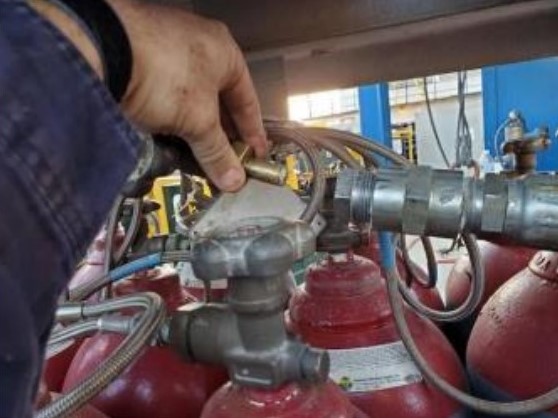In 2022, BSEE observed two hand injuries in the Gulf of Mexico from pressurized hoses during coil tubing operations. In both cases, the injured parties were not wearing proper impact gloves to help reduce the severity of a hand injury.
The incidents
Incident 1: A flexi coil hose was filled with 5.5 bbls of saltwater during a pressure test and tested to 10,000 psi for 10 minutes. The pressure was bled to 6,000 psi through a needle valve at the pump’s discharge following the successful test.
[smlsubform prepend=”GET THE SAFETY4SEA IN YOUR INBOX!” showname=false emailtxt=”” emailholder=”Enter your email address” showsubmit=true submittxt=”Submit” jsthanks=false thankyou=”Thank you for subscribing to our mailing list”]
Once the pressure was bled to 6,000 psi, the contractor began releasing pressure from a ball valve on the upstream end of the flexi coil hose. While doing so, the flexi coil hose backlashed and pulled the valve from the contractor’s hand, causing the ball valve to contact the coil reel of the unit.
The ball valve came apart when it hit the unit, and the handle contacted his right thumb, causing a laceration. The injured contractor stated he was wearing latex gloves at the time of the incident. Right before opening the valve handle, he had been handling hydraulic oil.
Incident 2: Crewmembers were in the process of rigging up three nitrogen bottle racks to blowdown and purge the reel during rigging down operations. The job safety analysis (JSA) did not address the procedure for blowing down the reel dry and other associated hazards.
After a successful connection to the reel, the injured crewmember opened the three nitrogen bottle racks to pressurize the line. He then instructed another crew member to open the valve at the reel to begin purging the reel.
The crewmember partially opened the reel valve, equalizing the pressure across the valve, then opened the reel valve fully. After opening the reel valve, the nitrogen hose connecting the second bottle rack failed at the brass fitting, sending the pressurized hose whipping around.
The injured employee was struck in the hand, resulting in two broken fingers and multiple lacerations. The hose then struck a second employee in the arm, causing bruising and swelling of the forearm.
A crewmember then closed the reel valve to deenergize the nitrogen hose to remove the hazard. The injured crew member was not wearing impact gloves at the time of the incident.

Lessons learned
- Emphasizing the use of properly fitting gloves (e.g., impact, chemical, or a dual glove) in the JSA to reduce or eliminate the severity of sustained hand injuries.
- Establishing a policy/procedure to require employees to depress the line entirely or depressurize to a much lower pressure before an employee manipulates valves under pressure to avoid situations where a valve doesn’t cut out or is forced open when under stress.
- Ensuring that during pressure testing, hoses are secured to prevent them from moving. Avoid stressing small threaded connections by properly supporting hoses and tubing.
- Using a whip check across a pressurized hose connection to mitigate uncontrolled movement in the event of connection failure.
- Ensuring work involving hoses, piping (a.k.a. chiksan), or lines under pressure should either have whip checks installed and tied to the deck or a block of wood connected to the deck to keep minimal movement when under pressure.
- Verifying that all valves are in the correct position before pressurizing equipment.
- Reviewing MSDS/SDS and the manufacturer’s recommendations to determine the correct PPE before handling chemicals. The materials used in some protective gloves may provide excellent protection against specific chemicals but may be ineffective against others
- Reviewing the importance of discussing every job task and associated hazards during the creation of the JSA.
- Encouraging personnel to use Stop Work Authority when equipment is unsafe or they discover hazards not covered in the JSA.
- Maintaining an inventory of spare PPE for personnel who arrive at your facility with missing or inadequate PPE.
































































